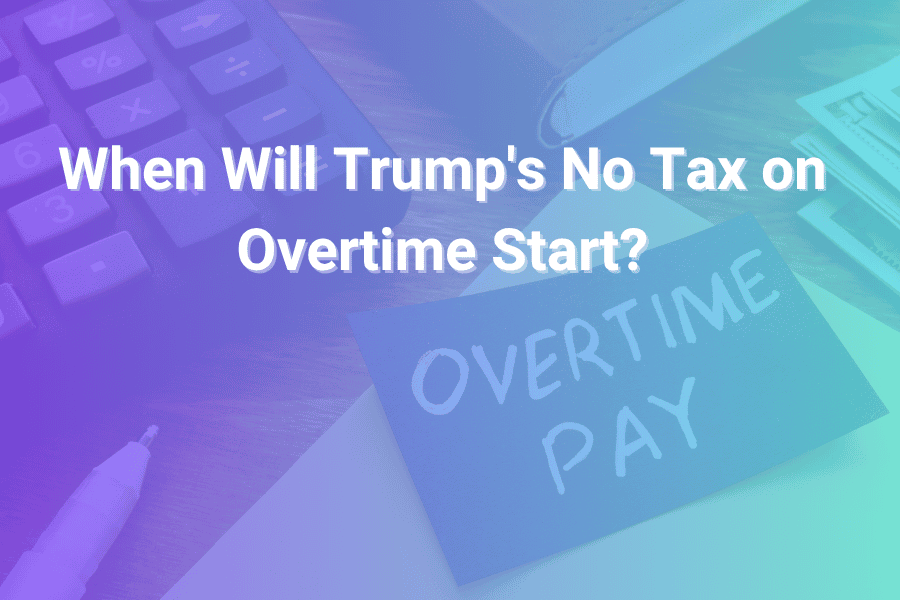
The landscape of taxation for working Americans is about to shift, with a monumental change on the horizon. In the wake of ongoing tax reforms under the current administration, one of the most significant provisions is the elimination of federal income tax on overtime pay.
This provision, introduced as part of President Trump’s One Big Beautiful Bill, aims to provide much-needed relief to hardworking individuals by exempting a portion of their overtime earnings from tax. But when exactly will this change take effect?
How will it impact your pay, and who will benefit from it? In this article, we’ll explore these questions and break down the important details you need to know about the “No Tax on Overtime” provision.
The Timeline for Trump’s Overtime Tax Exemption
The new law, which is poised to affect millions of workers across the country, is set to take effect on January 1, 2025. This date marks the beginning of a major shift in how overtime earnings are taxed in the United States. For the first time, employees working overtime will see a portion of their earnings go untaxed, significantly increasing their take-home pay.
The provision specifically targets overtime pay that exceeds the base salary thresholds. Under current federal law, overtime earnings are taxed at the same rate as regular income, often leaving workers with much less than they actually earn for extra hours worked. The One Big Beautiful Bill changes that by providing tax relief for eligible workers.
Who Will Benefit from the “No Tax on Overtime” Law?
The law applies to W-2 employees who are entitled to overtime pay under federal labor standards. While this includes a broad swath of workers across industries, it specifically impacts those in blue-collar sectors, such as manufacturing and service industries, where overtime is more common.
To be eligible for the new tax exemption, your overtime earnings must be above a certain threshold. For single filers, the exemption applies to overtime pay that exceeds the $47,476 salary threshold. For married couples filing jointly, the figure rises to $94,952. However, the overtime pay must still fall within the realm of federal labor law, meaning it must be reported as part of regular W-2 income and meet certain qualifications for it to qualify for this exemption.
How Will the Exemption Impact Workers?
For the average American worker, this new law will likely bring a welcome change. For years, overtime pay has been taxed as regular income, which means those working long hours to meet deadlines or fill in for labor shortages often end up with a smaller portion of their overtime earnings than they would like. The new law will not only allow workers to retain a greater portion of their overtime earnings, but it could also incentivize individuals to take on more hours and boost their overall productivity.
Key Benefits for Workers:
- Higher Take-Home Pay: With federal income tax no longer applied to a portion of overtime pay, workers will retain more of their hard-earned money.
- Increased Motivation for Overtime Work: Many workers shy away from overtime because the additional hours often don’t feel worth the extra tax burden. By removing this tax burden, the law encourages workers to take on extra shifts and contribute more to the economy.
- Better Financial Security: With more money staying in workers’ pockets, the new law will improve financial stability, particularly for families who rely on overtime to meet expenses.
Aiming to Revitalize American Manufacturing
This provision is particularly important for the manufacturing sector, which has struggled to attract and retain workers in recent years. Many manufacturing jobs require overtime, especially as companies try to meet high demand. With this tax incentive, workers may be more willing to join the manufacturing industry or stay in their roles longer, contributing to the overall manufacturing comeback that the bill envisions.
Impact on Employers
While workers stand to gain from this legislation, employers also stand to benefit in the long run. By eliminating tax burdens on overtime pay, employers can attract workers for overtime hours more easily, which may help in meeting production demands, especially during peak seasons. This change could also help companies remain competitive by ensuring they have the manpower needed to keep operations running smoothly.
However, employers will need to adjust their payroll systems to accommodate these new tax rules. Specifically, they must ensure that overtime earnings are properly reported on W-2 forms and differentiate between regular income and exempt overtime pay. This may require additional accounting work on their end, but the end result could be a happier, more motivated workforce.
Will the Change Apply to All Overtime Pay?
No, not all overtime pay will be exempt from taxation. There are certain exceptions, and it’s important to understand the full scope of the law. The exemption only applies to overtime earnings that are reported through standard W-2 forms. Self-employed individuals or independent contractors, who report income differently, will not be able to take advantage of this benefit.
Additionally, overtime pay earned through collective bargaining agreements or other state-level agreements may be subject to different tax rules. The law is intended to address federal overtime pay regulations, which are generally more uniform across the country.
How Much Will Workers Save?
While the exact amount that workers will save depends on their income, here are some general estimates:
- For a worker earning $50,000 annually with 10 hours of overtime per week, the tax relief could amount to around $1,200 per year, depending on their tax bracket.
- A higher-income worker earning $100,000 annually could see savings of around $2,400 per year in overtime-related tax relief.
These savings might seem modest at first glance, but when you factor in the potential for more overtime hours as a result of the tax incentive, workers could see a significant increase in their overall earnings.
How to Prepare for the Changes
Since the “No Tax on Overtime” provision won’t take effect until January 2025, there is ample time for workers and employers to prepare. For workers, this means keeping track of your overtime hours and understanding how much of your income will qualify for the exemption.
For employers, it will be crucial to start adjusting payroll systems and educating employees about the new benefits. Providing clear communication around how this change will impact their paychecks will help workers feel confident and excited about the transition.
Final Thoughts
The No Tax on Overtime provision is set to be a game-changer for many American workers, particularly those in sectors that rely heavily on overtime pay. With an effective start date of January 1, 2025, employees will soon see more of their overtime earnings remain in their pockets, boosting their take-home pay and financial stability. For employers, the change offers the opportunity to attract and retain a more motivated workforce, especially in industries like manufacturing.
While the law doesn’t go into effect immediately, workers and employers alike should begin preparing now to make the most of these tax-saving benefits. By understanding how this provision works and planning accordingly, both parties can ensure a smoother transition when the law officially takes effect.
